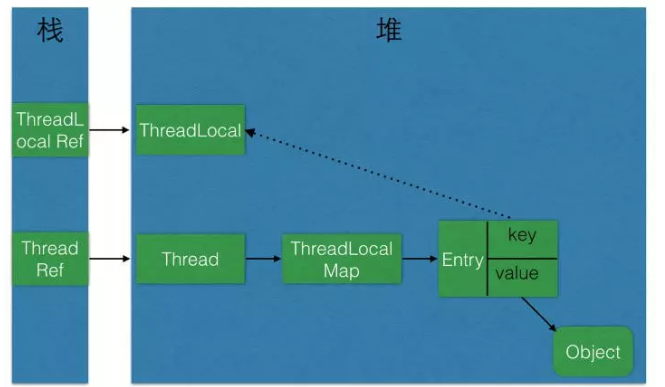ThreadLocal
ThreadLocal
1. 什么是ThreadLocal
我们先来看下JDK 的文档介绍
/**
* This class provides thread-local variables. These variables differ from
* their normal counterparts in that each thread that accesses one (via its
* {@code get} or {@code set} method) has its own, independently initialized
* copy of the variable. {@code ThreadLocal} instances are typically private
* static fields in classes that wish to associate state with a thread (e.g.,
* a user ID or Transaction ID).
*
* <p>For example, the class below generates unique identifiers local to each
* thread.
* A thread's id is assigned the first time it invokes {@code ThreadId.get()}
* and remains unchanged on subsequent calls.
*/
ThreadLocal提供了线程的局部变量。每个线程都可以通过set()和get()来对这个 局部变量进行操作,但不会和其他线程的局部变量进行冲突。实现了线程的数据隔离
简要言之:往ThreadLocal中填充的变量属于当前线程,该变量对其他线程而言是隔离的。
2. 为什么要学习ThreadLocal
从上面可以得出:ThreadLocal可以让我们拥有当前线程的变量,那这个作用有什么用呢???
2.1 管理Connection
最典型的是管理数据库的Connection:
当时在学JDBC的时候,为了方便操作写了一个简单数据库连接池,需要数据库连接池的理由也很简单,频繁创建和关闭Connection是一件非常耗费资源的操作,因此需要创建数据库连接池~
那么,数据库连接池的连接怎么管理呢??我们交由ThreadLocal来进行管理。为什么交给它来管理呢??ThreadLocal能够实现当前线程的操作都是用同一个Connection,保证了事务!
当时候写的代码:
public class DBUtil {
//数据库连接池
private static BasicDataSource source;
//为不同的线程管理连接
private static ThreadLocal<Connection> local;
static {
try {
//加载配置文件
Properties properties = new Properties();
//获取读取流
InputStream stream = DBUtil.class.getClassLoader().getResourceAsStream("连接池/config.properties");
//从配置文件中读取数据
properties.load(stream);
//关闭流
stream.close();
//初始化连接池
source = new BasicDataSource();
//设置驱动
source.setDriverClassName(properties.getProperty("driver"));
//设置url
source.setUrl(properties.getProperty("url"));
//设置用户名
source.setUsername(properties.getProperty("user"));
//设置密码
source.setPassword(properties.getProperty("pwd"));
//设置初始连接数量
source.setInitialSize(Integer.parseInt(properties.getProperty("initsize")));
//设置最大的连接数量
source.setMaxActive(Integer.parseInt(properties.getProperty("maxactive")));
//设置最长的等待时间
source.setMaxWait(Integer.parseInt(properties.getProperty("maxwait")));
//设置最小空闲数
source.setMinIdle(Integer.parseInt(properties.getProperty("minidle")));
//初始化线程本地
local = new ThreadLocal<>();
} catch (IOException e) {
e.printStackTrace();
}
}
public static Connection getConnection() throws SQLException {
if(local.get()!=null){
return local.get();
}else{
//获取Connection对象
Connection connection = source.getConnection();
//把Connection放进ThreadLocal里面
local.set(connection);
//返回Connection对象
return connection;
}
}
//关闭数据库连接
public static void closeConnection() {
//从线程中拿到Connection对象
Connection connection = local.get();
try {
if (connection != null) {
//恢复连接为自动提交
connection.setAutoCommit(true);
//这里不是真的把连接关了,只是将该连接归还给连接池
connection.close();
//既然连接已经归还给连接池了,ThreadLocal保存的Connction对象也已经没用了
local.remove();
}
} catch (SQLException e) {
e.printStackTrace();
}
}
}
同样的,Hibernate对Connection的管理也是采用了相同的手法(使用ThreadLocal,当然了Hibernate的实现是更强大的)~
2.2 避免一些参数传递
避免一些参数的传递的理解可以参考一下Cookie和Session:
3. ThreadLocal 实现的原理
public void set(T value) {
// 得到当前线程对象
Thread t = Thread.currentThread();
// 这里获取ThreadLocalMap
ThreadLocalMap map = getMap(t);
// 如果map存在,则将当前线程对象t作为key,要存储的对象作为value存到map里面去
if (map != null)
map.set(this, value);
else
createMap(t, value);
}
上面有个ThreadLocalMap,我们去看看这是什么?
static class ThreadLocalMap {
/**
* The entries in this hash map extend WeakReference, using
* its main ref field as the key (which is always a
* ThreadLocal object). Note that null keys (i.e. entry.get()
* == null) mean that the key is no longer referenced, so the
* entry can be expunged from table. Such entries are referred to
* as "stale entries" in the code that follows.
*/
static class Entry extends WeakReference<ThreadLocal<?>> {
/** The value associated with this ThreadLocal. */
Object value;
Entry(ThreadLocal<?> k, Object v) {
super(k);
value = v;
}
}
//....很长
}
通过上面我们可以发现的是ThreadLocalMap是ThreadLocal的一个内部类。用Entry类来进行存储
我们的值都是存储到这个Map上的,key是当前ThreadLocal对象!
如果该Map不存在,则初始化一个:
void createMap(Thread t, T firstValue) {
t.threadLocals = new ThreadLocalMap(this, firstValue);
}
如果该Map存在,则从Thread中获取!
/**
* Get the map associated with a ThreadLocal. Overridden in
* InheritableThreadLocal.
*
* @param t the current thread
* @return the map
*/
ThreadLocalMap getMap(Thread t) {
return t.threadLocals;
}
Thread维护了ThreadLocalMap变量
/* ThreadLocal values pertaining to this thread. This map is maintained
* by the ThreadLocal class. */
ThreadLocal.ThreadLocalMap threadLocals = null
从上面又可以看出,ThreadLocalMap是在ThreadLocal中使用内部类来编写的,但对象的引用是在Thread中!
于是我们可以总结出:Thread为每个线程维护了ThreadLocalMap这么一个Map,而ThreadLocalMap的key是LocalThread对象本身,value则是要存储的对象
有了上面的基础,我们看get()方法就一点都不难理解了
public T get() {
Thread t = Thread.currentThread();
ThreadLocalMap map = getMap(t);
if (map != null) {
ThreadLocalMap.Entry e = map.getEntry(this);
if (e != null) {
@SuppressWarnings("unchecked")
T result = (T)e.value;
return result;
}
}
return setInitialValue();
}
3.1 ThreadLocal 原理总结
- 每个Thread维护着一个ThreadLocalMap的引用
- ThreadLocalMap 是ThreadLocal的内部类,用Entry来进行存储
- 调用ThreadLocal的set()方法时,实际上就是往ThreadLocalMap设置值,key是ThreadLocal对象,值是传递进来的对象
- 调用ThreadLocal的get()方法时,实际上就是往ThreadLocalMap获取值,key是ThreadLocal对象
- ThreadLocal本身并不存储值,它只是作为一个key来让线程从ThreadLocalMap获取value。
4. 避免内存泄漏
我们来看一下ThreadLocal的对象关系引用图:

ThreadLocal内存泄漏的根源是:由于ThreadLocalMap的生命周期跟Thread一样长,如果没有手动删除对应key就会导致内存泄漏,而不是因为弱引用。
想要避免内存泄露就要手动remove()掉!
5. 总结
ThreadLocal设计的目的就是为了能够在当前线程中有属于自己的变量,并不是为了解决并发或者共享变量的问题